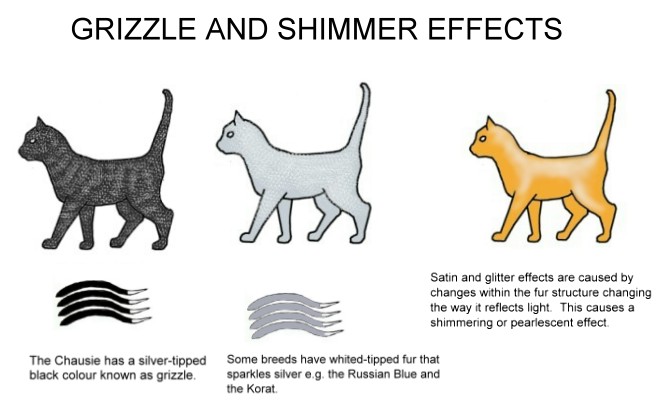
SATIN, GLITTER AND GRIZZLE IN CATS
I am indebted to Frank Whittenburg for his investigation into the satin-on-solid gene manifested by his Tennessee Rex cats and the use of his photographs. Similarly, I am grateful to Jamie Ackerson for the photos of her American Satin cats and to other contributors of photos and information.
In 1986, Wright and Walters noted in their "Book of the Cat" that satin was a highly sought after mutation in cats. This mutation, seen in mice and other rodents, gave a pearly sheen to the coat. Until recently, the closest breeders had to a satin effect was found in Siamese and Oriental cats. Their close-lying fur had a silky light-reflective sheen, though far less pronounced than the satin gene in rodents and probably due to polygenes rather than a single gene mutation.
In the Russian Blue, each hair should have a silvery tip, giving a sheen to the coat. In the 1990s, there was correspondence in cat magazines as to whether this was due to translucent "hollow" tips to the fur. The hollow hair-tip was declared undesirable in the breed.
In the 1990s, a sparkling white coat was developed on a short-lived British breed known as the Suqutranese by crossing Somalis with white shorthairs. The effect was due to translucent banding of the white hair-shaft. The breed's demise appeared due to the description of the cats as "white Somali-type," leading to antipathy from Somali breeders and a narrow-minded cat fancy in Britain (who released a statement condemning the cats). Hair from the Suqutranese was not microscopically examined, but was described as white with translucent banding. It could be recreated by crossing white shorthairs with Somalis and the fur examined.
With no confirmed glitter gene mutations in cats, even the cat breeders' bible "Robinson's genetics for Cat Breeders (4th Ed)" has nothing to say on the matter; the Bengal "glitter" gene was identified in 2022.
TYPES OF GLITTER, GRIZZLE AND SATIN MUTATION
Bengal breeders had noted an effect called "glitter" on some of their cats. This became desirable within the Bengal breed. On the brown Bengals, the effect was of "gold dust" (termed "golden glitter") while on silver Bengals it had a pearly effect. Although solid black Bengals sometimes occur due to recessive genes, the glitter effect seemed confined to the patterned Bengals and has been traced to an Indian cat used in the foundation stock. Initially it was thought to be a single recessive glitter gene termed "gl", but microscopic studies of hair types suggest there are 2 different types of glitter which are currently termed "Mica" and "Satin" by Bengal breeders. Mica glitter (recessive) affects the tips of hairs and results in reflective hair-tips with what appear to be small flecks of mica (a highly reflective silicate crystal) embedded in the tip and visible under a microscope. Unlike the satin mutation (which affects the length of the hair shaft), mica only affects the hair-tip. This type of glitter was present in a domestic cat used in Jean Mill's original hybrids between Asian Leopard Cats and domestics.
Chausie breeders also noticed a form of glitter which they termed "grizzle". Silver-tipped black is found in melanistic Jungle Cats (F chaus) and in the Chausie breed derived from Jungle Cat hybrids. This affects the hair tip and not the entire hair shaft. The Grizzle gene has not been fully investigated, but appears to have been introduced from melanistic Jungle Cats. Silver tipped black is seen in Jungle Cats.

Once a satin-on-solid mutation had been described and photographed, other cat breeders were more aware of what to look for. In England, Anthony Nichols reported a solid black 7 year old neutered male (Jasper) as having a satin coat. The possibility of a glittered black Bengal was ruled out and there was no way to reproduce the trait as the cat was neutered. Even if the parents could be mated again, there was no guarantee that this was not a mutation in Jasper himself. Hair from Jasper has not been investigated microscopically. It is possible that satin has turned up and been overlooked in other random-bred cats because the cats' owners didn't realise what they were looking at or because the cats (and their parents and siblings) had already been neutered by a cat rescue group, preventing the gene from being perpetuated. In 2018 another shimmering mutation was announcend in the form of the American Satin, formerly known as the Courtney Cat.
BENGAL GLITTER GENE
About 60% of all Bengal cats have the "glitter" trait. The researchers investigated the Fgfr2 gene responsible for "Glitter" in the coat. Glitter softens hair texture and produces an iridescent sheen to the coat. Glitter is a desirable breed trait inherited as an autosomal recessive. The Bengal breed has a regulatory mutation in gene Fgfr2 (Fibroblast growth receptor 2) , which arose in domestic cats and is responsible for "Glitter" in Bengals. The Fgfr2 mutation reduces the activity of the protein encoded by Fgfr2, but does not inactivate it. All the glittered cats tested had the same variant of the Fgfr2 gene. All glitter cats were homozygous for a mutation of Fgfr2, while all non-glitter cats were either heterozygous or homozygous for the wild-type allele. Researchers termed these Fgfr2gl (glitter) and Fgfr2+ (wild-type, non-Glitter). Glitter and the underlying Fgfr2 mutation are nearly specific to Bengal cats [note: other satin-coated breeds in development haven't been tested for Fgfr2 mutations, but their existence reinforces the domestic cat origin of "glitter"].
For all four types of hair (guard, awn, down, and awn-down), the width of the medulla in Fgfr2gl/gl hair is significantly reduced compared to Fgfr2gl+ or Fgfr2+/+ hair. Reduced medullary width is also associated with a similar trait called Satin in mice and rats (different genes are involved in each). Reduced medullary width may explain differences in hair texture but was unlikely to account for the characteristic Glitter/Satin appearance. There was an additional abnormality in down hairs, which account for 75% of the coat. Normally, the hair medulla contains a vertical array of keratinocytes that alternate with air cells. In down hairs this array becomes thin and fragmented towards the tip of the hair. In Fgfr2gl/+ or Fgfr2+/+ hair, the gap between the thin, fragmented portion of the medulla begins ~1mM from the tip, but in Fgfr2gl/gl hairs, that gap is 3 – 4 times larger. This is probably why glitter coats have a translucent and iridescent appearance.
Researchers concluded that Glitter is caused by reduced expression of Fgfr2 that leads to changes in hair thickness and structure without affecting hair structure or function.
- Christopher B. Kaelin, Kelly A. McGowan, Anthony D. Hutcherson, John M. Delay, Gregory S. Barsh, Ancestry dynamics and trait selection in a designer cat breed, December 12, 2022,
THE FIRST CONFIRMED SATIN MUTATION - TENNESEE REX
In August 2004, cat lover Franklin Whittenburg in the Tennessee Valley in the Chattanooga area took in a straight-coated feral female and her 3 kittens, of which 2 had curly fur. In addition to their rex coats, the 2 kittens exhibited the coveted "satin" mutation. When the fur was viewed closely in direct sunlight, there appeared to be tiny little prisms along the length refracting the light into a rainbow spectrum. This effect is currently termed "satin-on-solid" to differentiate it from the satin associated with patterned Bengals although Whittenburg prefers the term "satin-on-rex" as the satin gene currently appears inseparable from the curled fur. Because data on satin-coated cats is lacking, Frank Whittenburg investigated the cause of the satin effect and likely manifestations through discourse with rodent breeders. He found two degrees of satinization: satin and radical satin (the latter being analogous to the double-satinization in rodents).
|
|
|
|
|
Tennessee Rex photos courtesy F Whittenburg |
||
Satin, or satin glitter, (recessive) affects the whole of the hair shaft. This type of mutation is found in fancy rodents (in some species, homozygous satin results in balding). The hair shaft contains air pockets along its length. These refract light and give the coat a pearlised effect also termed "oyster". The hair is soft, smooth and silky as a result of the air pockets in the hair shaft. The longer the air pockets, the softer and silkier the fur. Found in Bengals, Oriental-type cats and, to a limited degree, in straight-coat variants of Tennessee Rexes.
|
|
|
|
|
Left: Cream Satin. Right: Red Satin. Tennessee Rex photos courtesy F Whittenburg |
||
In the Tennessee Rex, the satin (which appears to behave as a recessive) on the original rex-coated males males is manifesting as a reflective coating material similar to oyster shell on the hair-shaft. It isn t yet known whether a single gene mutation produces both effects, or whether there are 2 mutated genes situated close to each other, that have so far been inherited together. At first, these were thought to be "air pockets" in the hair shaft that that refracted light rather than simply reflecting it. Closer examination of the satin on the original Tennessee Rex males showed a reflective coating material similar to oyster shell on the hair shaft along with triangular ridges. Straight haired offspring showed some air-pockets. Normal cat hair has a relatively solid core of pigment. Satin Tennessee Rex hair has looser, irregular bands of pigment while glittered Bengal hair has more tightly packed pigment granules forming a narrower core. Hairs from crosses of satin Tennessee Rex x glittered Bengal more closely resemble those of the Bengal than the Tennessee Rex.
|
|
At first, it was thought that Tennessee Rex Satin was related to the recessive Bengal Glitter mutation. A satin-coated Tennesse Rex test-mated to a high glitter Bengal female had a normal shiny coat, but did not exhibit either Glitter or Satin. This proved the mutations were different (this was later confirmed by DNA analysis). The kittens were all neutered and not used in either breed. An outcross of Tennessee Rex female to a domestic shorthair male also produced shiny-coated but not Satin-coated straight-haired offspring. Carriers of the gene appear to exhibit a degree of shine while the "radical satin" effect has appears restricted to the rex-coated individuals. The satin mutation may be linked to the rex mutation in the same way that Bengal glitter appears linked to the Bengal patterns. This is similar to the expression of Satin in mice where homozygous mice (2 copies of the recessive gene) are satin-coated, and heterozygous mice (1 copy of the gene) may show a lesser degree of satin. However, if all heterozygotes have a degree of satin then this is also the behaviour of a dominant gene with an additive effect - mild satin in heterozygotes and "radical satin" in homzygotes.
Tennessee Rex satinization can make creams appear brownish, pinkish or even bluish. Orange cats can have a blue cast, while agouti blacks can look silver. This is due to the way the light is reflected from the hairs. A more recently reported satin mutation, in Oregon, USA, produces a more prominent frosting, and blueing effect, with some kittens looking fever coated at birth.
At one point the number of Tennessee Rexes became critically low and there was a risk of losing the unique satin mutation. Thankfully breeders have rescued the breed and a spontaneous satin rex cat in Australia proved to have the same mutation and has been used to reinvigorate the gene pool.
THE NEW ZEALAND AND AUSTRALIAN SATIN REXES
Below is a New Zealand Satin Rex mutation. A neutered household pet with a single patch of rexed/shiny fur on the shoulders. This effect has been observed in one other neutered pet cat.
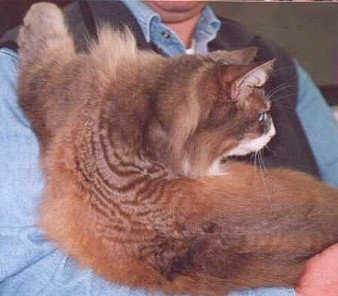
Below are photos of two satin rexes born in Mackay, Queensland, Australia in 2016. The curls have decreased with age and the satin has increased. These came from a litter of 4 kittens that came into Kim Gale's pet shop. Their parents are unknown. All 4 kittens were rexed. Two were 2 desexed immediately and Kim decided to invesigate the rex and satin with the other two as they had been compared to the Tennessee rex. Golden Gale is a short hair rex female with pronounced satin/glitter in her coat. Her sister, Twisted Gale, is a longhair rex girl and the satin is best seen on her legs. Both have had curly-haired kittens and it remains to be seen if these kittens lose the curl and inherit the satin fur.
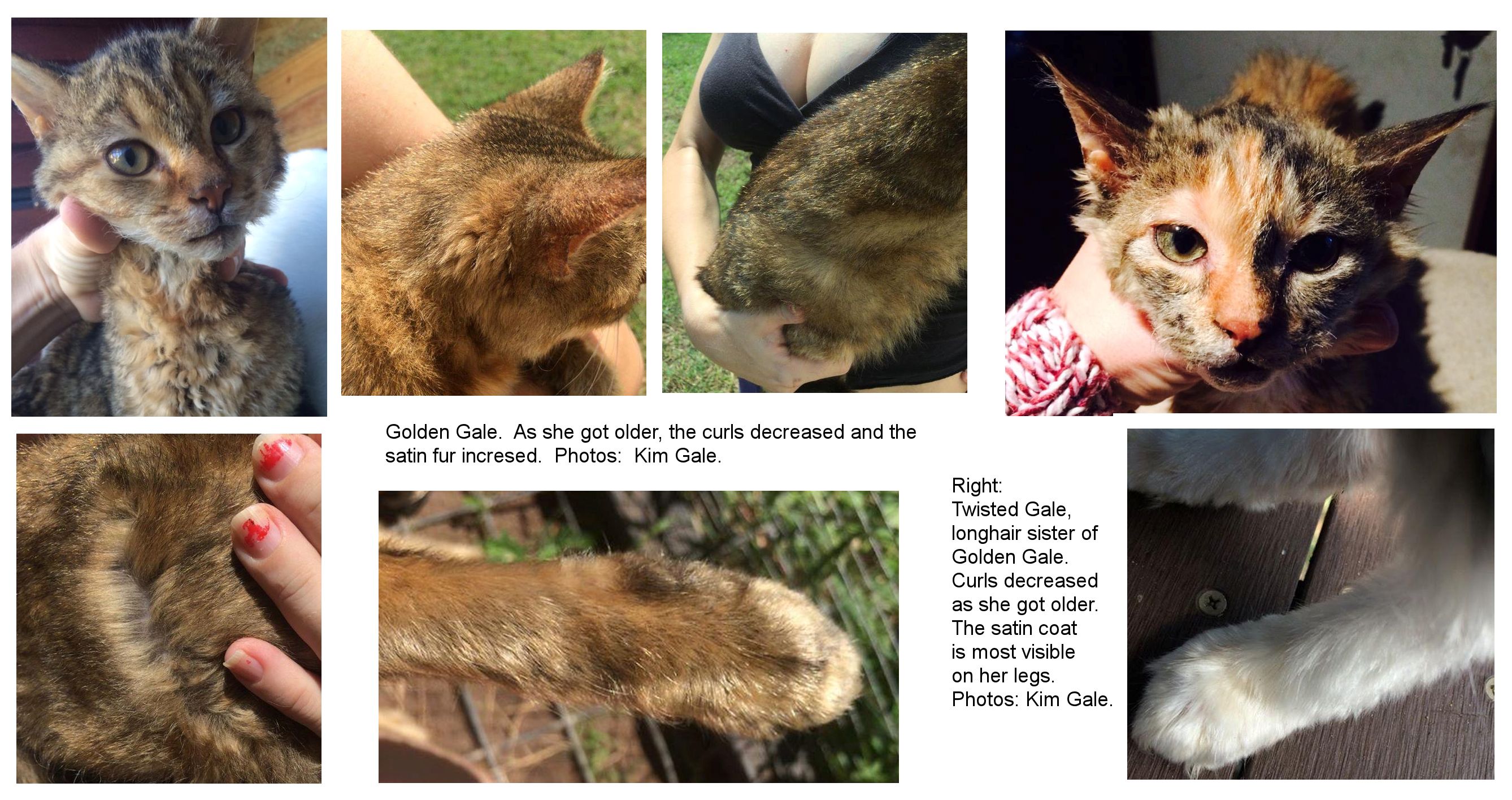
Golden Gale was sent to Canada where she was test mated to a Tennessee Rex cat. She had only two kittens but BOTH were satin rex, meaning the Australian cats have the same mutation as the Tennessee rex cats. Golden Gale had amazing satin for a torbie. The two kittens were a red tabby, Joey Boy, and a black torbie, Koala Girl. Kathryn Stokey, WV, USA owns Koala Girl who has been bred to a Tennessee Rex carrier (a non- rex cat carrying the gene) and produced 5 kittens , 3 rexed and 2 carriers. All of the kittens look like they also will develop amazing satin coats.
AMERICAN SATIN - THE SHIMMERING OREGON CATS
The American Satin breed is being developed by Jamie Ackerson and are also informally known as Courtneys based on their region of origin. This information and the accompanying photos is from 2018 - 2019.
In 2014 an abandoned dilute calico (i.e. blue cream and white) was impregnated by a free-roaming blue and white bobtailed cat prior to being rescued by Jamie Ackerson in Brownsville, Oregon, USA. When the kittens were born they sparkled in the sun. Jamie kept a female kitten along with the mother cat and rehomed the rest. The calico Queen, named Momma Courtney after the street she was rescued on, was bred to a second bobtail male to see if the new kittens would also sparkle and shine in the sun. Not knowing much about cats Jamie started research while reaching out to the internet communities for information. After several litters the breed had evolved into a small to medium sized cat with large inquisitive eyes, a naturally athletic build and fur that feels like silk. Both males and females are deceptive in size to weight so should be no taller than 11" at the shoulder, and weigh 7 lbs to 14 lbs for males and 6 lbs to 9 lbs for females.
The satin cat has an unusual richness in eye and coat colour, as well as depth to its fur that causes it to change hues in the light. This same gene can also cause an unusual paleness to eye and coat colour that is as striking as the richly coloured cats. It is common to see the American Satin with a pink, neon blue, greenish, steel grey, golden, buff or purple hue to their fur. Although all coat colors and patterns are accepted, there are only 4 recognized coat descriptions for the American Satin.
1. Shine: Shiny fur, lacking a down coat. May look greasy on dark or long haired cats.
2. Sparkle: Matte shine
3. Frost: White tipped agouti hairs that may appear all over or on large portions of the body. Not confined to background colour.
4. Shimmer: A thick down coat is necessary to achieve the shimmer look (lack of down coat results in the "Shine" effect). Visually it looks like a combination of shine and Frost, and on a tabby pattern i has the effect of causing the pattern to 'disappearing or shimmering from view' as the cat moves. Heavy ticking and Satin on Wideband Agouti.
Apart from Shine (lacking down coat) and Shimmer (presence of down coat) these categories may appear individually or simultaneously in any combination.
Another special trait of the American Satin is a raised dorsal stripe that appears on the short haired cats. The raised stripe runs along the dorsal ridge from neck to tail, and is caused by inward growing hairs that form a peak along the back.
American Satins have a shimmering coat due to translucent or white hair-tips to their agouti hairs and awn hairs. Usually the tips of agouti (banded) hairs are black. The white tips produce a shimmering effect and make the coat appear paler and appear to glow in certain light due to the combination of refraction and reflection. When the cat is in motion, the coat glistens.
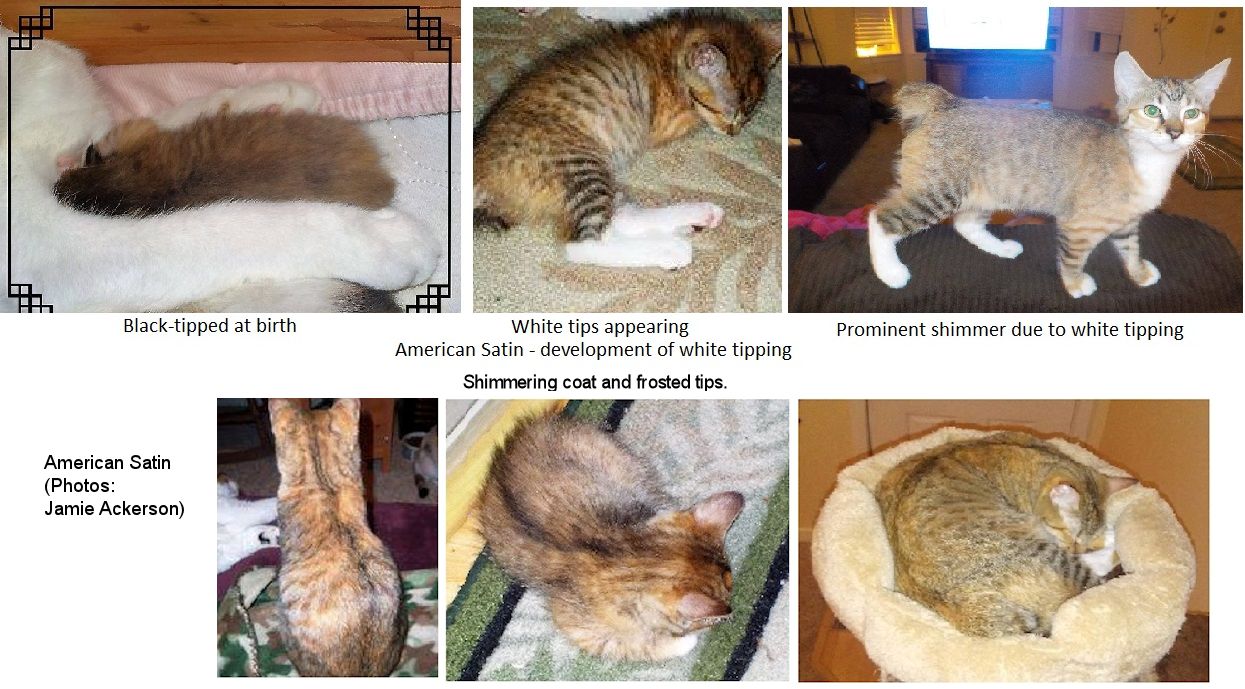
A sample agouti hair on a Courtney cat is banded white, dark, white, dark, white, but is not silver. Against a white background the white bands vanish, while against a dark background the dark bands vanish. Another sample hair had a white base, then agouti banding that obscured the cat s spotted tabby markings and tipping that visibly alternated between black and white. The cumulative effect was a shimmering coat. When the cats are kittens, the hair-tips tend to be a normal black colour, but change to white or translucent later on. The white tipping can be present all over the coat or only on part of it, typically on the dorsal region. The photos show the progression from normal black-tips on a kitten to a shimmering white-tipped coat as an adult.
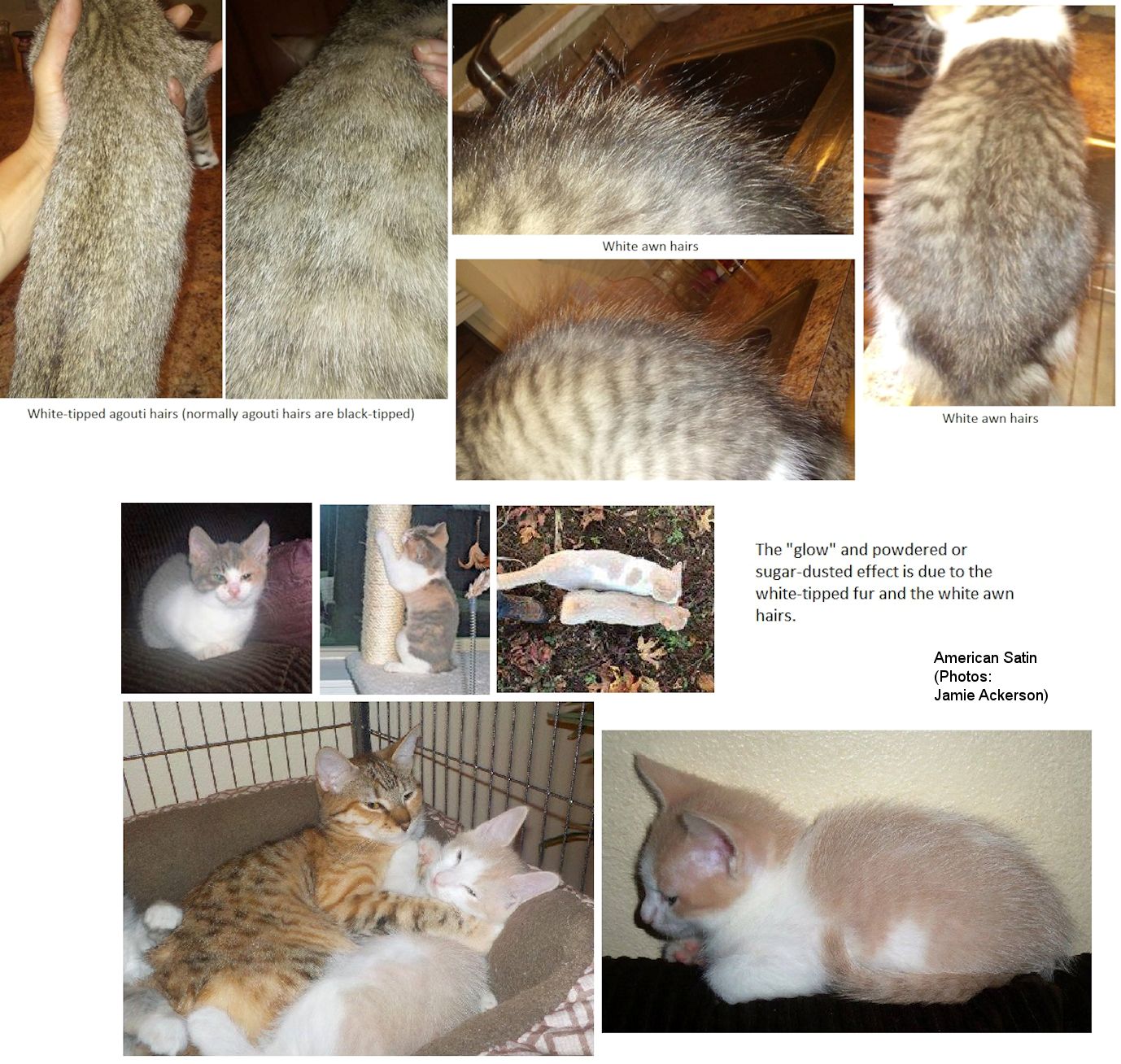
Martinian Rio Prince has photographed the guard hairs of American Satin Cats under high magnification.
"I made an interesting discovery this morning while inspecting a sample of Iona's fur. It appears that the distinctive sheen of the American Satin is due to the unique cellular structure of the keratin in some of the guard hairs. In the first picture, we see a typical guard hair, with a thick, smooth shaft that reflects light as a single line along the middle of the shaft. In the second and third photos, we see a very different surface, which under the microscope looks almost like facets or wrinkles. Due to a lack of good macrophotography equipment, I was not able to capture this very well, but we can see how light is reflected in many tiny reflections. This gives that distinctive sheen to the fur in bright light. But what about the pastel-colored sheen of pink/blue/purple highlights which we also observe?
Under closer inspection at higher magnification, some guard hairs appear translucent, revealing the inner structure of the blocky keratin cells. Imagine a column of crackled glass. In the case of these hairs, there appears to be a diffraction of light into a few separate bands of wavelength, which I was not able to capture. The many different angles trap and split light waves into colors, much like a CD reflects sunlight as a color spectrum. Only some of the cells reflect color, others are white light. This mixture of color and white light creates the pastel color effect. This would indicate that further breeding over time to select for the attributes of translucent hair growth could result in cats with more colorful coats, particularly those with lighter colored fur, which reflects more light."
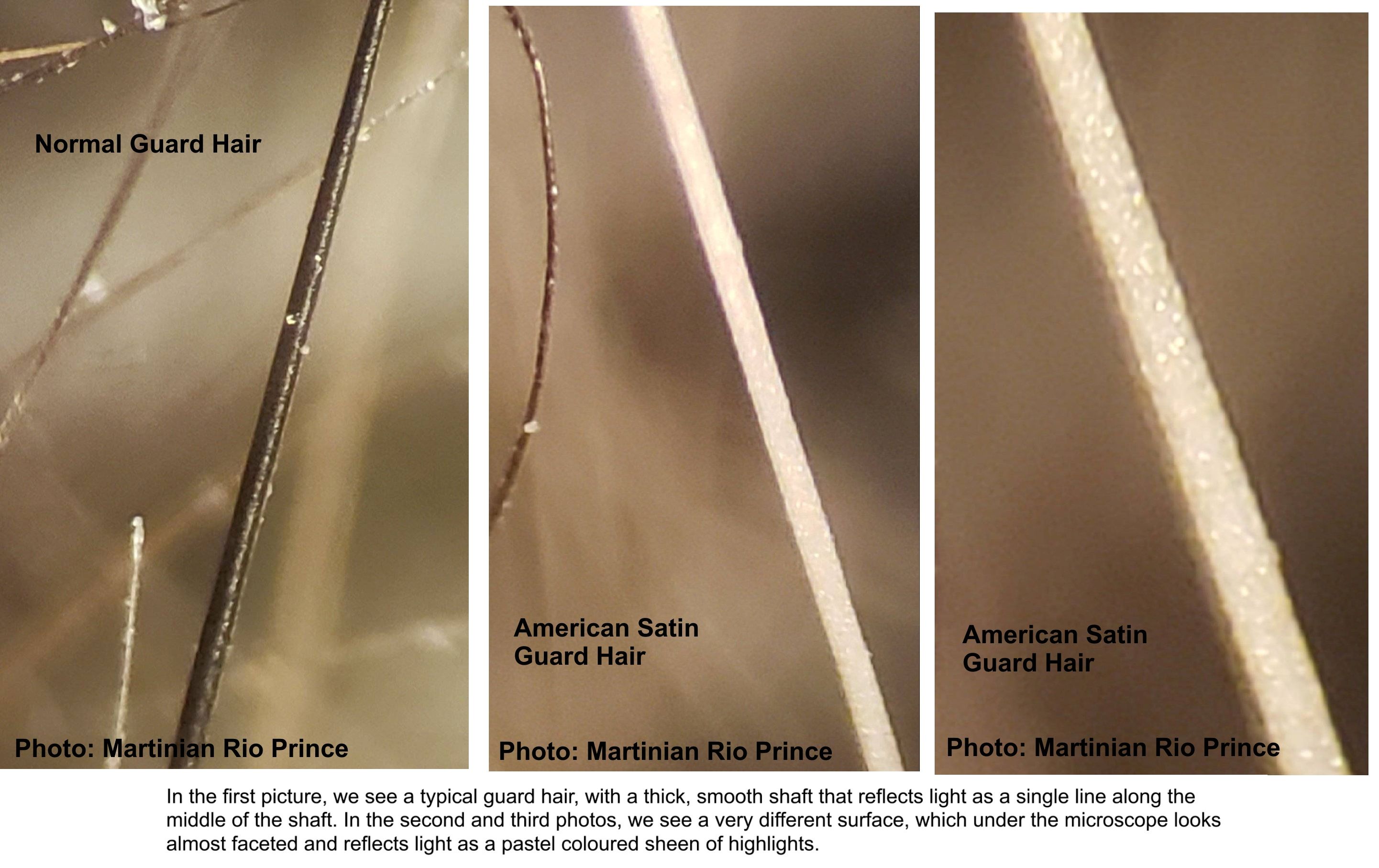
"Broken whiskers" will be permitted in the breed standard and are related to the satin coat. The short, "broken" whiskers of the American Satin, seen in the second generations of purebred cats. The whiskers start out short, but will grow in full by five months of age. Below are two different litters of kittens and an adult.
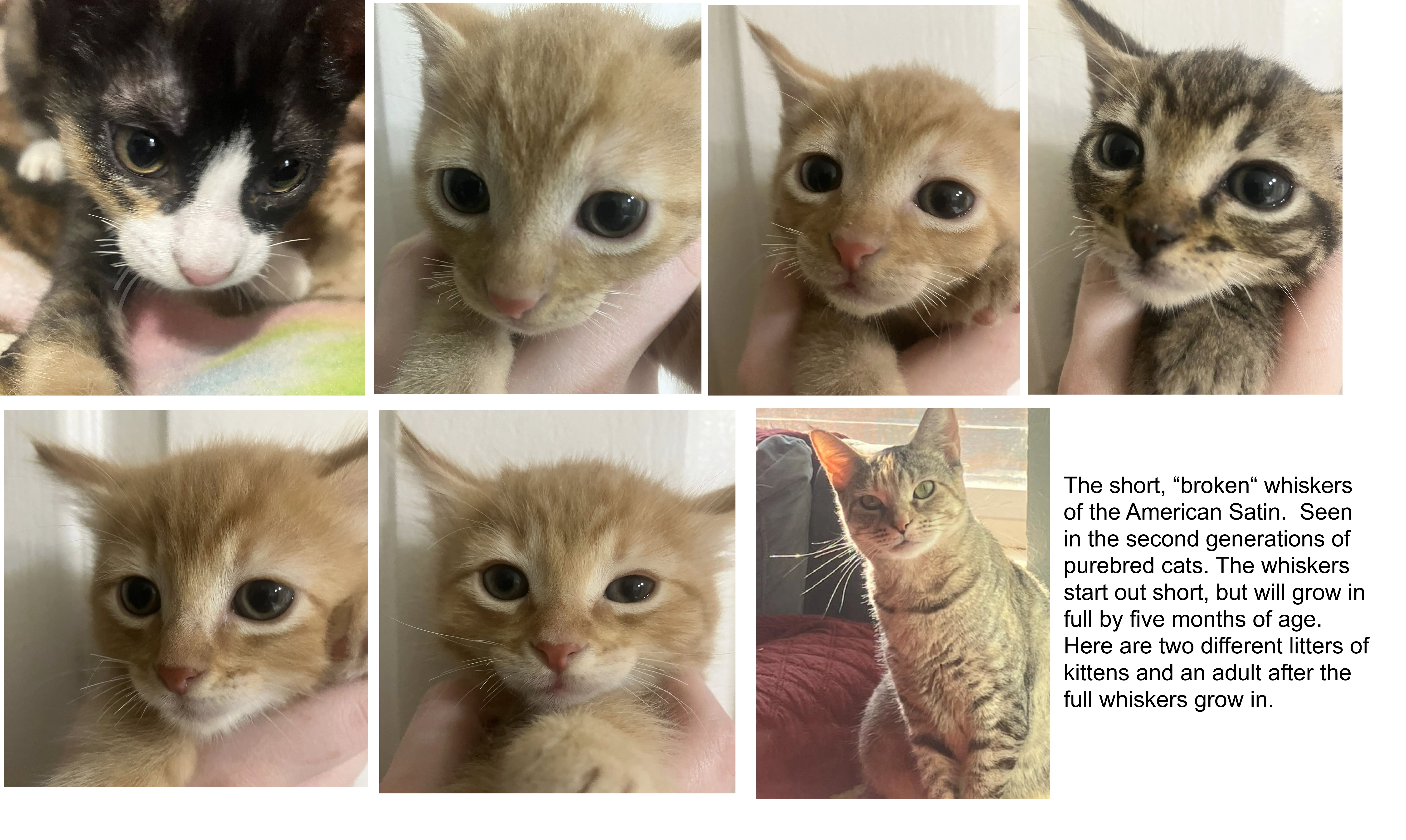
GLISTENING CATS FROM LOUISIANA
Early in 2019, Rett Bowman (near Baton Rouge, Louisiana) sent me information about Miracle, her kinky, curly cat with iridescent paws and tail and it turned out that Miracle's nephews and nieces appeared to have a satin mutation. In 2014, Rett had taken in a pale silvery blue longhaired kitten, "Puff Puff" whose fur was wavy, with kinky hairs and shimmered in sunlight as though sprinkled in fairy dust. Puff Puff had come from a neighbour and later mated with a short haired black male belonging to another neighbour. This male also had a shimmering coat. Puff produced a pale blue short haired shimmering male and a black short haired shimmering female. Being an indoor/outdoor colony, the two offspring mated with each other, and also with a neighbour s cat. Evidently a "glistening" gene was already in the local gene pool as the kittens had shimmering, iridescent fur beyond the ordinary shine of short-haired cats. Unfortunately the cats were met with a mix of scepticism and hostility by some breeders working with satin genes in cats at the time.
Miracle's mother gave birth to 3 kittens (her second litter) in March 2019. Two of the kittens had glistening fur with prismatic rainbow colours whenever the sunlight caught the fur. One kitten is a brown tabby, the other is a tortoiseshell, and both have fairly straight guard hairs, with thick curly and kinky awe and down hair. The mother of the glistening kittens' half-sister also had a litter (5 kittens) and Rett is waiting to see if they have glistening fur.
After Hurricane Ida (August 2021) Rett took in some unspayed American Curl cats, including a semi-longhaired black satiny female named Hera who also had very iridescent fur. They were being spayed, but Miracle managed get to Hera, resulting in four glistening, shimmering black and white cats. In 2021, Rett moved to a farm in the country which had room for a cattery, and she is further investigating the glistening, shimmering fur type.
Rett is an expert on rex rabbits and knew what she was looking at. She had also researched the Tennessee Rex cat and currently has American Curl cats. The glistening kittens could be a new mutation or might be compatible with one of the existing satin mutations in development. More photos at: Glistening Kittens. To contact Rett, MsLorettaBowman@gmail.com or RettAmericanCurlCats@gmail.com
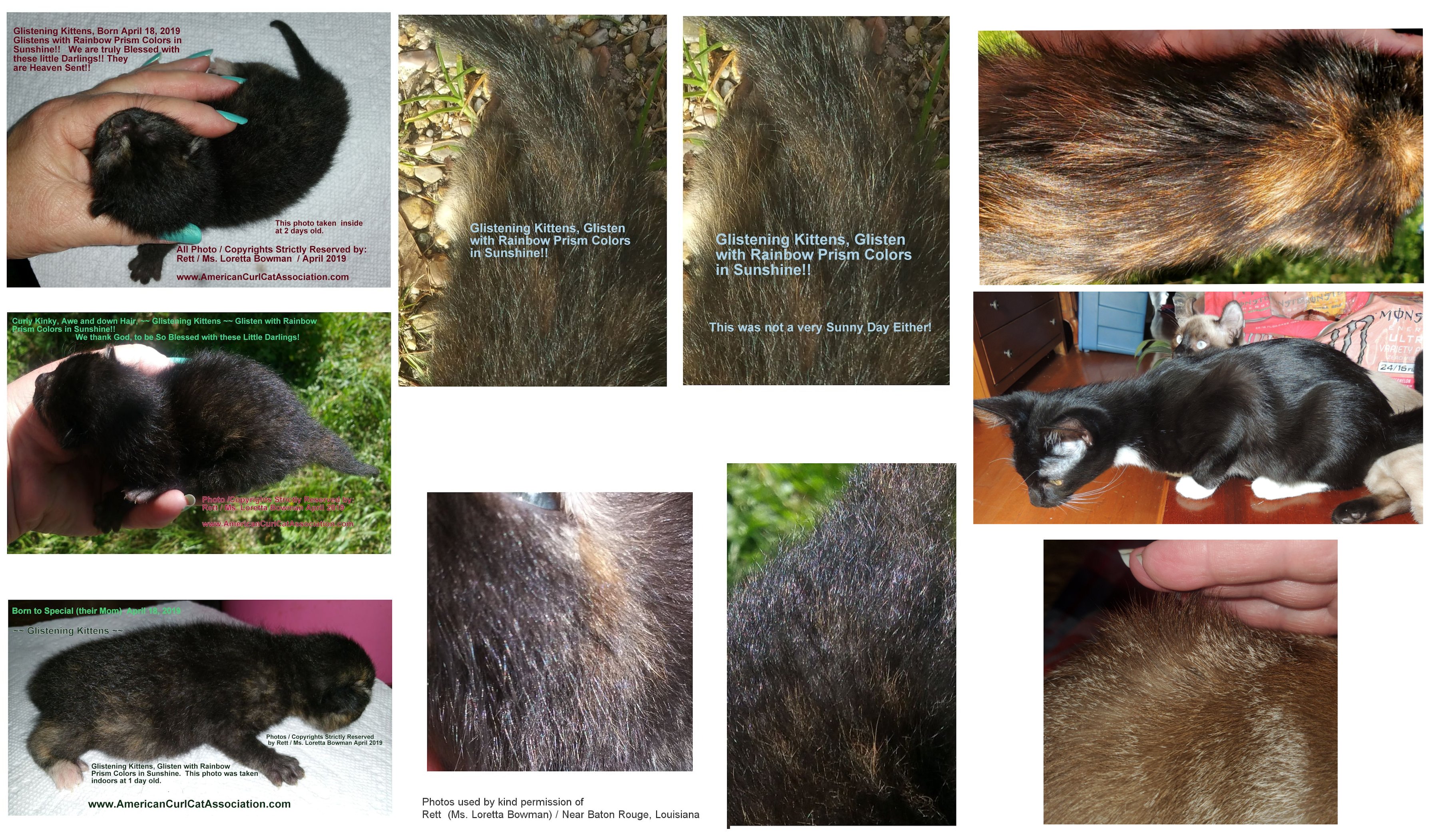
WAVES AND GLITTER IN CATS FROM MANCHESTER, ENGLAND
2023: Ellie Monaghan owns a tortoiseshell with what seems like a glittered coat as well as some loose curls/curly whiskers and medium-short hair. She came from a breeder in Manchester, England, however neither of the parent cats or any other siblings from previous litters had any glitter or curly coats, they were all solid short haired cats so it seems like it was a spontaneous mutation in just her, or due to recessive genes. She is similar to the description of a Tennessee Rex.
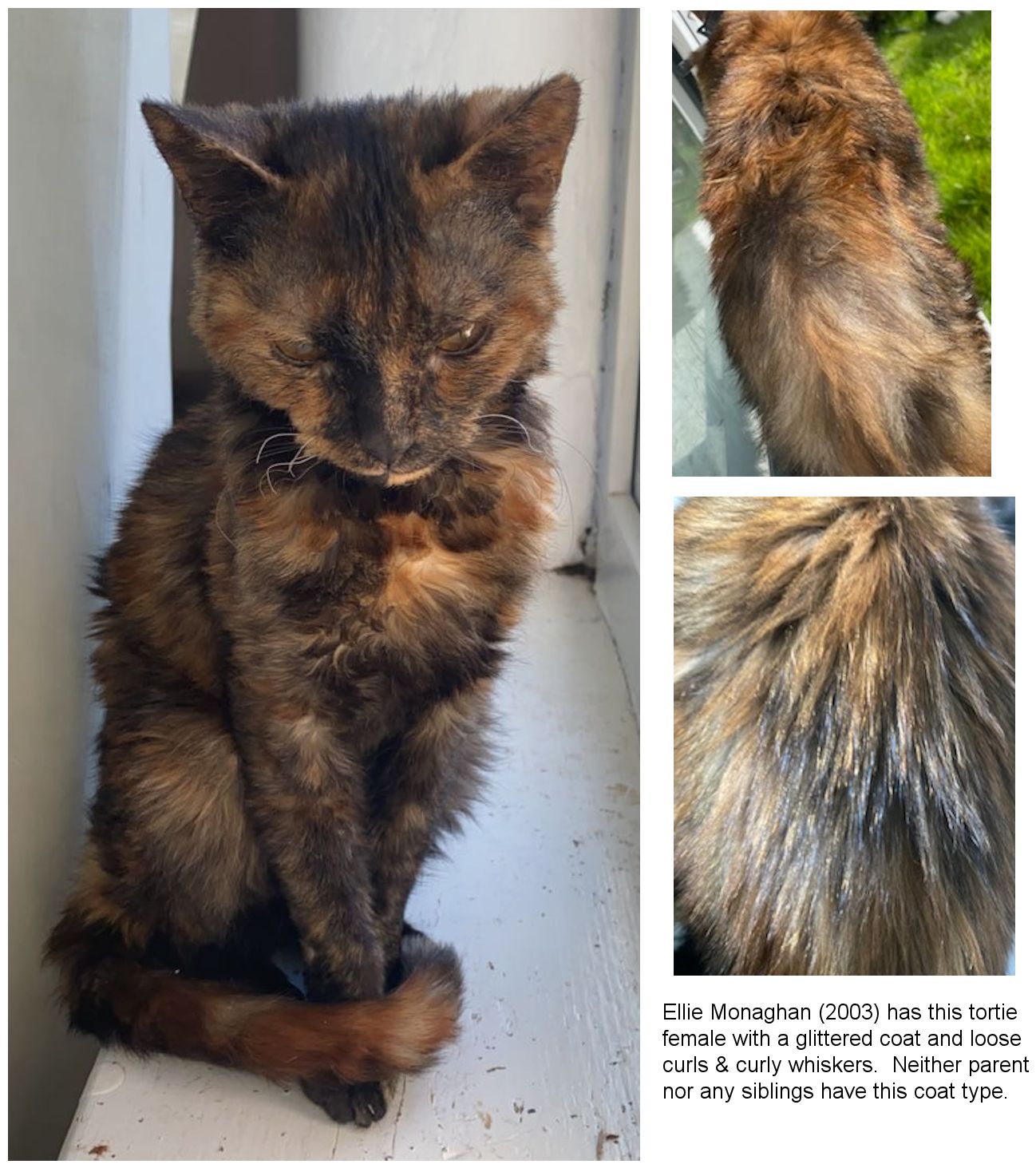
INHERITANCE OF GLITTER AND SATIN
In the Bengal, the 2 posited types of glitter (satin glitter and mica) both show a recessive pattern of inheritance are seen only on patterned cats. Solid black Bengals are few and far between, but those that exist apparently lack either type of glitter (there may simply be too few of them to confirm this). In 2021, I learnt that Chris Kaelin had found the gene for Bengal glitter and that this gene is not present in the Tennessee Rex. The satin gene hasn t yet been identified.
In the Tennessee Rex, satin appears linked to the rex mutation which is a recessive gene. At the time of writing, the Tennessee Rex cats are 2.5 years old and the satin-on-solid effect have mostly been seen on red cats, plus one straight-coated blue (grey) cat which had a "frosted" appearance. If this rainbow effect mutation were to occur in a white Tennessee Rex it would produce "oyster shell" or "pearl" colour that would be unique to the breed.
The mode of inheritance on Jasper, the 7 year old black cat, is unknown and, because the cat is neutered, cannot be determined. It is not possible to test-mate Jasper to a Tennessee Rex. It is also not known (at least at the present time) whether either parent was satin-coated; whether they were normal-coated but able to produce satin-coated offspring (a recessive satin mutation) or whether the mutation occurred within Jasper himself and not his parents (in which case probably a dominant mutation).
In the Suqutranese, the sparkling effect appeared due to the interaction of epistatic white and agouti banding. This could be recreated, but there appears to be prejudice against the breed/type.
It is not known what the future holds for the satin-on-solid gene or the Tennessee Rex. The mutation itself is stunning and the new breed is extremely attractive. Conceivably some breeders may wish to explore satin in straight-coated cats derived from Tennessee Rexes and in all colours and fur lengths. There is the possibility that some breeders may want to create "satinized" versions established breeds in the same way that some envisaged short-legged versions of those breeds. At present there are only a few satin-coated cats in existence and more breeders required to perpetuate the trait in the Tennessee Rex breed before even considering its possible introduction into other breeds.